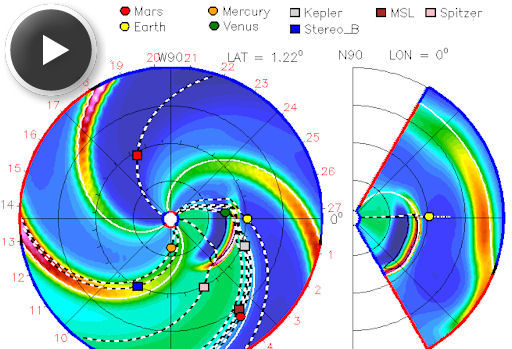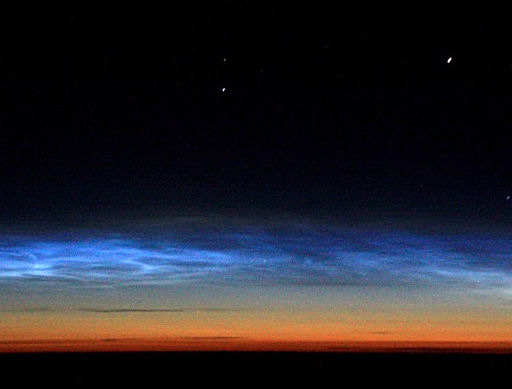ASTEROID FLYBY: Newly-discovered asteroid 2012 LZ1 is flying past the Earth-Moon system today. At closest approach on June 14th (23:10 UT), the 500 meter-wide space rock will be 14 lunar distances (3.3 million miles) away. A team of astronomers led by Ernesto Guido photographed the incoming asteroid on June 13th: images.
CME TARGETS VENUS, EARTH MARS: Active sunspot AR1504 erupted on June 13th at 1319 UT, producing a long-duration M1-flare and hurling a CME into space. According to analysts at the Goddard Space Weather Lab, the cloud will deliver a glancing blow to three planets: Venus on June 15th, Earth on June 16th, and Mars on June 19th. This animation shows the likely progression of the cloud:
NOAA forecasters estimate a 25% - 30% chance of geomagnetic storms when the cloud reaches Earth. High-latitude sky watchers should be alert for auroras. Solar flare alerts: text, voice.
ELECTRIC-BLUE NOCTILUCENT CLOUDS: Data from NASA's AIM spacecraft show that noctilucent clouds (NLCs) are like a great "geophysical light bulb." They turn on every year in late spring, reaching almost full intensity over a period of no more than 5 to 10 days. News flash: The bulb is glowing. Flying photographer Brian Whittaker photographed these NLCs over Canada on June 13th:
"I was very happy to see my first noctilucent clouds of 2012," says Whittaker. "They were visible to the north for about 3 hours as we flew between Ottawa and Newfoundland at 35,000 feet."
These electric-blue clouds are hanging 85 km above Earth's surface, at the edge of space itself. Their origin is still largely a mystery; various theories associate them with space dust, rocket exhaust, global warming--or some mixture of the three. One thing is sure. They're baaack ... for the summer of 2012.
Observing tips: NLCs favor high latitudes, although they have been sighted as far south as Colorado and Virginia. Look west 30 to 60 minutes after sunset when the Sun has dipped 6o to 16o below the horizon. If you see luminous blue-white tendrils spreading across the sky, you may have spotted a noctilucent cloud.

![]()
Solar wind
speed: 363.6 km/sec
density: 1.9 protons/cm3
explanation | more data
Updated: Today at 1646 UT
![]()
X-ray Solar Flares
6-hr max: M1 1436 UT Jun14
24-hr: M1 1436 UT Jun14
explanation | more data
Updated: Today at: 1600 UT
![]()
![]()
![]()
Daily Sun: 14 Jun 12
![]()
![]()
Sunspot 1504 poses a growing threat for Earth-directed M-class solar flares. Credit: SDO/HMI
![]()
![]()
![]()
Sunspot number: 145
What is the sunspot number?
Updated 13 Jun 2012
Spotless Days
Current Stretch: 0 days
2012 total: 0 days (0%)
2011 total: 2 days (<1%)
2010 total: 51 days (14%)
2009 total: 260 days (71%)
Since 2004: 821 days
Typical Solar Min: 486 days
Updated 13 Jun 2012
The Radio Sun
10.7 cm flux: 143 sfu
explanation | more data
Updated 13 Jun 2012
![]()
![]()
![]()
Current Auroral Oval:
![]()
Switch to: Europe, USA, New Zealand, Antarctica
Credit: NOAA/POES
![]()
![]()
![]()
Planetary K-index
Now: Kp= 1 quiet
24-hr max: Kp= 2 quiet
explanation | more data
![]()
Interplanetary Mag. Field
Btotal: 3.3 nT
Bz: 0.9 nT south
explanation | more data
Updated: Today at 1642 UT
![]()
![]()
![]()
Coronal Holes: 13 Jun 12
![]()
![]()
There are no large coronal holes on the Earthside of the sun. Credit: SDO/AIA.






